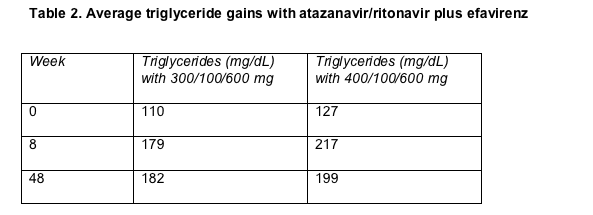 |
 |
 |
| |
Nucleoside-Sparing Regimen Coupling Atazanavir/Ritonavir and Efavirenz
|
| |
| |
46th ICAAC, September 27-30, 2006, San Francisco
Mark Mascolini
September 28, 2006
Two atazanavir/efavirenz regimens that avoid nucleoside analogs controlled HIV in just more than 60% of previously untreated study participants for 48 weeks [1].Triglycerides jumped higher than in earlier studies of atazanavir or efavirenz with two nucleosides.
Bristol-Myers Squibb, which makes the two components of this regimen, sponsored this unblinded 48-week trial in several HIV clinics across the US. Of the 61 people who began treatment in the study, 85% were men and 49% white. The median pretreatment CD4 count stood at 305 and the median viral load at 4.97 log copies/mL (almost 100,000 copies). Clinicians randomized enrollees to atazanavir/ritonavir at 300/100 mg or 400/100 mg once daily plus standard-dose efavirenz.
The rationale for the 400/100-mg atazanavir/ritonavir dose rests on earlier studies establishing low atazanavir concentrations in people also taking efavirenz. Gary Thal from Bristol-Myers Squibb noted that, with the standard 300/100-mg dose plus efavirenz, atazanavir levels rise only as high as those seen when atazanavir has no ritonavir boost.
After 48 weeks both intent-to-treat and on-treatment analyses showed equivalent virologic responses to the two regimens (Table 1). Yet the sub-50-copy intent-to-treat response rates look low by recent standards. For example, 48-week intent-to-treat sub-50 rates were 80% with efavirenz/tenofovir/emtricitabine and 70% with efavirenz/AZT/3TC in an open-label study that enrolled 517 previously untreated people [2]. CD4 gains averaged 271 in the 300/100-mg arm and 250 in the 400/100-mg arm.

But virologic response was not the primary endpoint of this trial. Instead the principal aim was to measure changes in fasting triglycerides between week 0 and week 8. During those 2 months, triglycerides rose steeply in both the 300/100 arm and the 400/100 arm (Table 2). Thal confirmed that these triglyceride jumps exceed those seen earlier with unboosted 400-mg atazanavir, 300/100 mg of atazanavir/ritonavir, or efavirenz. The gains stabilized after week 8 but clearly left some people above the normal range. Five percent of people in the combined arms had a triglyceride reading above 400 mg/dL at week 48.

Dangerous low-density lipoprotein (LDL) cholesterol jumped 11% in the 300/100-mg arm by week 8 and 13% in the 400/100-mg arm, but LDL did not rise farther through 48 weeks. "Good" high-density lipoprotein (HDL) cholesterol, on the other hand, did continue to climb after week 8. In the 300/100-mg group the week-8 gain averaged 29% and the week-48 gain 54%. HDL cholesterol surged 26% by week 8 in the 400-mg group and 45% by week 48.
Overall rates of treatment-related grade 2 to 4 "events" were equivalent in the two treatment arms--in 8 people (26%) taking 300/100 mg and in 9 (30%) taking 400/100 mg. But the 400/100-mg group had much higher grade 3 to 4 total bilirubin rates (40%) than did the 300/100-mg group (13%). Grade 3 to 4 alanine and aspartate aminotransferases elevations occurred in 10% and 7% taking the lower atazanavir dose and in 7% and 3% taking the higher dose.
Deciding whether a first-line protease inhibitor/nonnucleoside regimen offers any advantage over standard nucleoside-containing combinations depends not only on response and side effect rates, but also on how the virus mutates during virologic failure. AIDS Clinical Trials Group study A5142 randomized 753 treatment-naive people to efavirenz plus two nucleosides, to lopinavir/ritonavir plus two nucleosides, or to efavirenz plus lopinavir/ritonavir with no nucleosides [3]. Among the 33 virologic failure samples genotyped in the efavirenz/nucleoside arm, 16 (48%) had nonnucleoside mutations. Among the 39 failures genotyped in the efavirenz/lopinavir arm, 27 (69%) had nonnucleoside mutations. In the much smaller atazanavir trial, Thal had genotypic results on only 3 people whose regimen failed. None had major PI mutations, 2 had the nonnucleoside K103N mutation, and one had a substitution at reverse transcriptase position 179.
References
1. Ward D, Bush L, Thiry A, et al. Atazanavir/ritonavir and efavirenz NRTI-sparing regimens in treatment-naive adults: BMS-121 study. 46th ICAAC. September 27-30, 2006, San Francisco. Abstract H-1057.
2. Gallant JE, DeJesus E, Arribas JR, et al. Tenofovir DF, emtricitabine, and efavirenz vs. zidovudine, lamivudine, and efavirenz for HIV. N Engl J Med 2006;354:251-260.
3. Riddler SA, Haubrich R, DiRienzo G, et al. A prospective, randomized, phase III trial of NRTI-, PI-, and NNRTI-sparing regimens for initial treatment of HIV infection--ACTG 5142. XVI International AIDS Conference. August 13-18, 2006. Toronto. Abstract THLB0204.
|
| |
|
 |
 |
|
|